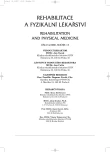The Gait Analysis of the Person with Trans-tibial Amputation
Authors:
M. Janura 1; Z. Svoboda 1; D. Kozáková 1; D. Birgusová 2
Authors‘ workplace:
Katedra biomechaniky a technické kybernetiky, Fakulta tělesné kultury UP, Olomouc
1; Rehabilitační oddělení, Nemocnice Frýdek-Místek
2
Published in:
Rehabil. fyz. Lék., 13, 2006, No. 4, pp. 190-193.
Category:
Original Papers
Overview
The previous function patterns cannot be applied for the individual with a partial amputation of the lower limb (also of the upper limb). The walk re-education requires careful definition of all abnormalities in the patient’s gait that differ from the standard pattern of muscle activity and the proper movement of joints. It is valid also for the patients with lower limb amputations executed between the knee joint and the ankle joint, i.e.trans-tibial amputation. A wide spectrum of biomechanical methods is utilized for a complex analysis of movement in orthotics and prosthetics (a combination of kinematic and dynamic methods, complemented with EMG and with the measuring pressure on the body contact with the ground). Their application serves for the comparison of various types of the prosthetic feet, as well as for the assessment of health condition, intensity of movement activities, etc. The main task is to analyse movement and to specify the load bearing on the sound limb. Biomechanics has an important place in the multidisciplinary team, which is essential for the complex care of trans-tibial amputees.
Key words:
trans-tibial amputation, gait, biomechanics
Labels
Physiotherapist, university degree Rehabilitation Sports medicineArticle was published in
Rehabilitation & Physical Medicine

2006 Issue 4
Most read in this issue
- Vertebrogenic Complaints and Stabilizing Function of Muscles – Diagnostics
- The Role of Diastasis Recti Abdominis in Genesis of Low Back Pain
- Pain as a Factor Indicating and Limiting Rehabilitation
- Muscle Dysbalance of Cervical Muscles
